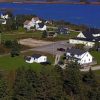Newly released information further calls Industrial Approval into question
[Sipeknekatik District]– In recently released documents accessed through Access to Information and Freedom of Information legislation, Water Protectors have learned that Alton Gas’ current plan to release high concentration brine into the Sipekne’katik/ Shubenacadie River would be out of compliance with Environment and Climate Change Canada’s (ECCC’s) general prohibition on the release of deleterious substances into waterways where fish frequent.
Alton Gas is planning to release brine at over six times (260 ppt) the concentration that ECCC deems deleterious (40 ppt). ECCC confirmed this to Alton Gas back in 2016, and according to documents, ECCC was even considering enforcement action in 2018 over the planned release. Environment and Climate Change Canada administers Section 36 of the Fisheries Act, the key pollution prevention provision which prohibits the deposit of deleterious substances into waters frequented by fish, unless authorized by regulations under the Fisheries Act or other federal legislation.
Meanwhile, Nova Scotia Environment (NSE) has continued to pave the way for Alton Gas to release full strength brine into the Shubenacadie river ecosystem. “Environment Minister Margaret Miller was quoted yesterday saying that she trusted the science behind this project and that consultation was adequate, but how could that possibly be true?” asked Mi’kmaq rights holder and Water Protector Michelle Paul. “The science shows that the salt brine exceeds a safe limit deemed by Environment Canada, and it is not even clear that this information was available during the consultation period.”
Water Protectors have been speaking out about the potential impacts of this project since 2014, calling for NSE and other authorities to hold Alton Gas to account. Mi’kmaq rights holder and Water Protector Dale Poulette asks, “If the Industrial Approval is valid then why are the Feds making an exemption to release this brine into the river? You don’t have a valid industrial approval when you haven’t engaged appropriately with relevant Federal authorities.”
As Grassroots Grandmother Dorene Bernard adds, “Despite what Miller may say, there has not been consultation or community engagement on Alton Gas with Sipekne’katik Chief Mike Sack and Council since May 24 2017, where Treaty rights holders voted ‘No’ on a potential Impact Benefit Agreement. It took two years for her to say that there was adequate consultation on a 2016 permit but there hasn’t been consultations to date.”
Water Protectors also learned from released documents that Alton Gas is investigating the option to install fish barriers in their proposed mixing channel so that fish cannot come in contact with the highly concentrated brine. This plan would require an amended approval and has been under discussion with NSE out of view of the public eye and without consultation with Mi’kmaq rights holders or local communities.
Contact:
Dorene Bernard – Grassroots Grandmother
Michelle Paul – Water Protector
Sadie Beaton – Ecology Action Centre
Attachments
Paula Jackman; Mike Beale (1); Mike Beale (2); Shawn Sanson; McNally (1); McNally (2)




I work as a high School guidance counselor in our first Nation community of Eskasoni. I am devastated about the courts allowing this to happen. This is beyond devastation. I will have to tell my students that this current government and their policies are destroying our future natural resources. This is totally unacceptable. The fish cannot talk, that’s why our people are trying to speak for them. So saddened.
I fish the stewiacke river every year but lost interest since the start of the alton gas mess, its just not the same and the fish don’t seem to be as active in my opinion also hunted Stevens rd for 42 years and now that whole area and animals will be gone
I’ve been talking with my students about this case from a decolonizing/sovereignty and Indigenous worldview perspective. They struggle (and they’re adults!!) to see how any responsible person would be in favour of this. Personally, I am beyond disgusted with the level of cavalier callousness this takes to so blithely damage an ecosystem.
If they recognise the need to build barriers, then they recognise that what they are doing is morally and ethically wrong. Environmental degradation and pollution of our marine ecosystems. Plain and simply wrong. How much is an ecosystem? What’s it worth?
This is heartbreaking and makes me ashamed to be Canadian – that this is happening! 😩💔